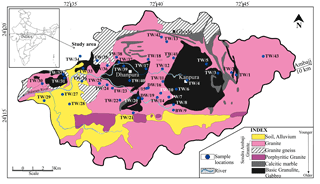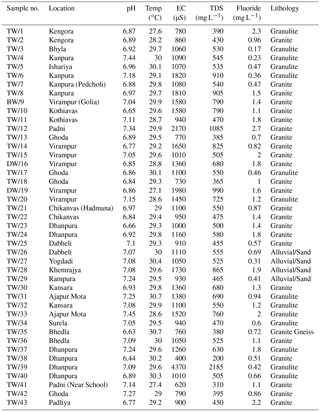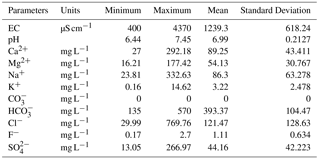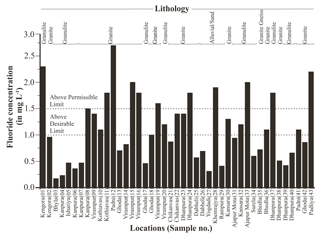Apambire, W. B., Boyle, D. R., and Michel, F. A.: Geochemistry, genesis, and
health implications of fluoriferous groundwaters in the upper regions of
Ghana, Environ. Geol., 33, 13–24, 1997.
Ayenew, T.: The distribution and hydrogeological controls of fluoride in the
groundwater of central Ethiopian rift and adjacent highlands, Environ. Geol.,
54, 1313–1324, 2008.
Ayoob, S. and Gupta, A. K.: Fluoride in drinking water: a review on the
status and stress effects, Crit. Rev. Env. Sci. Tech., 36, 433–487, 2006.
BIS: 10500: Specification for Drinking Water, Indian Standard Institution
(Indian Bureau of Standard), New Delhi, 1–4, 1991.
Brindha, K. and Elango, L.: Fluoride in Groundwater: Causes, Implications and
Mitigation Measures, in: Fluoride Properties, Applications and Environmental
Management, edited by: Monroy, S. D., 111–136, 2011.
Brunt, R., Vasak, L., and Griffioen, J.: Fluoride in groundwater: probability
of occurrence of excessive concentration on global scale, Igrac:
International Groundwater Resources Assessment Centre, Report nr. SP 2004-2,
1–12, 2004.
CGWB: Groundwater quality scenario in India, Central Ground Water Board,
Government of India, New Delhi, 2015.
Chinoy, N. J., Sequeira, E., Narayana, M. V., Mathews, M., Barot, V. V.,
Kandoi, P. R., and Jhala, D. D.: A survey of fluoride in 90 endemic villages
of Mehsana and Banaskantha districts of North Gujarat, India, Fluoride, 38.3,
224, 2005.
Dar, M. A., Sankar, K., and Dar, I. A.: Fluorine contamination in
groundwater: a major challenge, Environ. Monit. Assess., 173, 955–968, 2011.
Deshmukh, A. N., Wadaskar, P. M., and Malpe, D. B.: Fluorine in environment:
A review, Gondwana Geol. Mag., 9, 1–20, 1995.
Edmunds, W. M. and Smedley, P. L.: Fluoride in natural waters, in: Essentials
of medical geology, 311–336, Springer, Dordrecht, 2013.
Gupta, S. C.: Chemical character of groundwater in Nagaur district,
Rajasthan, Ind. J. Environ. Hlth., 33, 341–349, 1991.
Handa, B. K.: Geochemistry and genesis of Fluoride-Containing ground waters
in India, Groundwater, 13, 275–281, 1975.
Handa, B. K.: Fluoride occurrences in natural water in India and its
significance, BHU-Jal News, 3, 21–24, 1988.
Jacks, G.: Mineral weathering studies in Scandinavia, in: The Surface Waters
Acidification Programme, 215–222, Cambridge University Press, 1990.
Li, P., Qian, H., Wu, J., Chen, J., Zhang, Y., and Zhang, H.:
Occurrence and hydrogeochemistry of fluoride in alluvial aquifer
of Weihe River, China, Environ. Earth Sci., 71, 3133–3145, 2014.
Li, P., Tian, R., Xue, C., and Wu, J.: Progress, opportunities, and key
fields for groundwater quality research under the impacts of human activities
in China with a special focus on western China, Environ. Sci. Pollut. R., 24,
3224–13234, 2017.
Nordstrom, D. K. and Jenne, E. A.: Fluorite solubility equilibria in selected
geothermal waters, Geochim. Cosmochim. Ac., 41, 175–188, 1977.
Raj, D. and Shaji, E.: Fluoride contamination in groundwater resources of
Alleppey, southern India, Geosci. Front., 8, 117–124, 2017.
Rao, N. S.: Controlling factors of fluoride in groundwater in a part of South
India, Arab. J. Geosci., 10, p. 524, 2017.
Reddy, D. V., Nagabhushanam, P., Sukhija, B. S., Reddy, A. G. S., and
Smedley, P. L.: Fluoride dynamics in the granitic aquifer of the Wailapally
watershed, Nalgonda District, India, Chem. Geol., 269, 278–289, 2010.
Shaji, E., Viju, J., and Thambi, D. S.: High fluoride in groundwater of
Palghat District, Kerala, Current Science, 240–245, 2007.
Sharma, J. D., Parul, J., and Deepika, S.: Geological study of fluoride in
groundwater of Sanganer tehsil of Jaipur district, Rajasthan, India,
Fluoride, 38, p. 249, 2005.
Shekhar, S., Ghosh, M., Pandey, A. C., and Tirkey, A. S.: Impact of geology
and geomorphology on fluoride contaminated groundwater in hard rock terrain
of India using geoinformatics approach, Applied Water Science, 7, 2943–2956,
2017.
Singh, Y. K., De Waele, B., Karmakar, S., Sarkar, S., and Biswal, T. K.:
Tectonic setting of the Balaram-Kui-Surpagla-Kengora granulites of the South
Delhi Terrane of the Aravalli Mobile Belt, NW India and its implication on
correlation with the East African Orogen in the Gondwana assembly,
Precambrian Res., 183, 669–688, 2010.
World Health Organization (WHO): Fluoride and human health, WHO monograph series
no. 59, 1970.
Wu, J. and Sun, Z.: Evaluation of shallow groundwater contamination and
associated human health risk in an alluvial plain impacted by agricultural
and industrial activities, mid-west China, Expos. Health, 8, 311–329, 2016.










